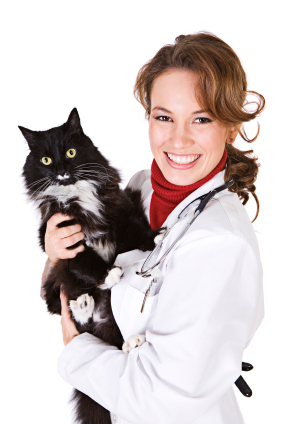Common Cat Medications

Do you ever wonder just a bit about the medicine your veterinarian is prescribing to your cat but maybe you were afraid to ask? Here is a quick look at some of the medications commonly used by veterinarians and what they're for.
Antibiotics for Cats
This is a very large group of medicines and your cat is likely to be prescribed one at some point in life. These medications do not treat infections caused by viruses or fungi; just those caused by bacteria.
Over the years, resistant strains of bacteria have arisen by mutation so that great care must be exercised in the use of antibiotics. This adaptation by bacteria is a natural phenomenon, but one which we try to discourage. We can help reduce the emergence of new resistant bacteria by administering all of the medication which has been dispensed, according to the prescribed schedule. Giving only part of a prescription or giving the medicine at irregular intervals can encourage resistant germs to grow.
Avoid flushing any outdated antibiotic down the toilet because it ends up in rivers and lakes and can affect wildlife. Instead, return any old medicines to the veterinary hospital for proper disposal.
Some antibiotics can treat classes of different bacteria (broad spectrum) while others effectively target only one or a few specific types of bacteria (narrow spectrum). Some of the antibiotics we prescribe are not specifically labeled for use in cats, and your veterinarian will advise you in that case. The drug companies cannot afford to do licensing trials in all of the minor animal species, so veterinary specialists and learning institutions carefully do trials, and once that has happened and results are published, the general practitioner will often adopt these newer “off-label” drug uses if they have shown efficacy.
Some frequently noted side effects with oral antibiotic administration include vomiting and diarrhea. Stomach upset may be reduced by feeding the cat at the time of the drug administration. Allergic reactions to antibiotics in cats are rare, and if you suspect a serious reaction, take your cat to the hospital immediately. With treatment, the reaction usually subsides quickly.
Cats don’t usually love taking their medications, and antibiotics are no exception. Some antibiotics are very bitter, and if you crush the pill to try to give it as a powder, this may trigger profuse drooling and some dark looks. Only break pills open if advised to do so by your pet’s doctor.
Ask your veterinary staff to demonstrate the proper way to give the prescribed medication to your cat. You can check out the following articles for some tips, too: "Tips for Giving a Cat a Pill," and How To Give Liquid Medications."
Anti-Inflammatory Medications for Cats
As the name implies, these types of medicines help reduce inflammation. They have other effects in the body as well, some desirable and some not. Some also have quite powerful anti-fever (antipyretic) effects and can also be effective pain killers (analgesics).
Non-Ateroidal Anti-Inflammatory Drugs (NSAID)
This subset of anti-inflammatories is very popular for home treatments for people. Aspirin, acetaminophen, ibuprofen, ketoprofen, and others are common in the household first aid cabinet. Unfortunately, cats lack the enzyme system in their livers to effectively process this type of medication, so as a group they are considered unsafe to give to cats. The rare exception is the prescription use of children’s dosage of aspirin at very long dose intervals for limited applications such as thromboembolism prevention. A few other NSAIDs are also considered safe at specific doses for short periods of time in cats, under strict veterinary supervision. None of these, including aspirin should EVER be selected for care of cats at home, since the consequences can be serious or life-threatening. If a cat accidentally gets into any of these drugs, an immediate trip to the vet hospital is in order.
Steroids
These are also anti-inflammatory drugs, but of a different class. Another word for them is glucocorticoids. If you know of people and dogs that have been prescribed prednisone, prednisolone, or other common steroid preparations, you will know that in these species, side effects are common. Side effects also occur in cats, but they do seem to be a bit more tolerant of this type of medication than dogs or humans. Increased thirst, weight gain, and increased urination are common side effects. If high or long-term doses are given or doses are not tapered, other more serious effects including diabetes mellitus can potentially develop. Long-term use can lead to changes in skin and liver, and at high doses, the immune system is suppressed, so an increased susceptibility to infection occurs.
In spite of all these concerns, these drugs do play a key role in the management of certain diseases of cats and can help improve quality of life in some situations.
Creams and Ointments for Cats
Many types of medication are delivered topically. However, most cats hate any creams or ointments. They are so fastidious that as soon as you apply it, they take it off unless they are physically restrained from reaching the area. For this reason, unless topicals are used with protective bandaging or head cones that prevent grooming an area, topical treatments are a tough sell to cats.
A cream is a water-soluble preparation, while an ointment has an oily base. Both can work to hold antibiotics or steroids or natural compounds in suspension so that they are held against the skin. Some new medications are delivered trans-dermally, using special vehicles that permit enhanced absorption through the skin. One painkiller called fentanyl can be delivered via a patch attached to the shaved skin, but it is important the cat not be able to get at it and chew it up, which can cause severe toxicity.
Fluids for Cats
Another frequently used pharmacy item for cats is intravenous or subcutaneous fluids. Fluids is a broad term used to describe solutions of varying compositions that can help replace body fluids, minerals, vitamins, and electrolytes lost due to lack of intake of food and water, bleeding, vomiting and diarrhea, burns, and kidney or multi-system disease.
We normally talk about IV’s when we refer to fluids administered into veins. Fluids are sometimes given by other routes in special circumstances such as in tiny kittens that have small, fragile vessels, or when veins are collapsed due to severely low blood pressure. Subcutaneous (SC or subQ) fluids are given under the skin. Not all fluids can be given by the SC route. Sometimes SC fluids are prescribed to be given at home to help maintain normal hydration in cats with chronic kidney failure.
Common fluid types are replacement formulations that are designed to replenish specific blood component deficiencies such as potassium, magnesium, and calcium and replace a volume of lost blood water. Others are rich in glucose to help cats with low blood sugar (hypoglycemia) to normalize. The other fluid type is termed maintenance formulation. These are used to maintain the normal blood volume and balance once a patient is stabilized, but is not yet drinking normally. Sometimes, vitamins or drugs are added to the fluid line to provide therapy or special nutritional support.
Sometimes in veterinary medicine, oral electrolyte solutions are selected to help replace fluid loss, but cats tend not to take them with anything approaching enthusiasm.
Digestive Disorder Products for Cats
Products to treat digestive system disorders in cats are many and varied. Severe constipation may be treated with an enema product, but human drugs like Fleet ® enemas are very toxic to cats, so enema products should only be used under veterinary supervision. Lubricating products may be used to help deal with hairballs or low grade constipation. Many of these hairball gels come in a tube with yummy caramel or tuna flavor and vitamins mixed into them. Constipated cats, especially seniors, may need to be given a fiber supplement to help keep them regular. Some diets have higher fiber to bulk up the diet, while other times a specific fiber supplement is added, such as psyllium or pumpkin. Another approach is to use stool softeners that help to increase the water content of the stool or laxatives that stimulate the guts to move the contents along.
Diarrhea may be treated with protectants, anti-parasitics, motility modifiers, antibiotics, or anti-inflammatory medications, depending on the cause. If a food allergy is suspected, a prescription hypoallergenic diet may be considered. Sometimes appetite stimulants, nutritional supplements, and other adjunctive treatments are prescribed.
Vomiting and nausea may be treated with antiemetics to help soothe the signals that stimulate the vomit reflex.
Hormone Replacement or Inhibition for Cats
Diabetes Mellitus may result from a shortage of functional insulin hormone, and sometimes insulin injections are prescribed to normalize blood sugar levels. Animal sources of insulin exist, and sometimes human recombinant insulin is used. Cats tend to require the longer acting preparations of insulin. This is a potent drug, and your veterinarian will demonstrate how to properly store the medication, gently mix the vial, and administer the precise dose under the skin. If overdose of insulin occurs, the blood sugar can drop severely, leading to sleepiness or even seizures. Rubbing corn syrup on the gums can help to maintain a cat during transport to the hospital for stabilization of low blood sugar. Diet may be adjusted also to help reduce blood sugar swings. Oral hypoglycemic agents and special prescription diets with high protein and low carbohydrate content may be used.
During hyperthyroidism, excess thyroid hormones are produced, and sometimes drugs are used to stabilize the cat. The medication does not fix the underlying problem—only surgery or radiation therapy can remove the overactive tissue and fix the condition. Instead, this type of medication helps to prevent the hormones from affecting the tissues and this helps to reduce the signs of the disease.
Anti-Viral, Cancer, and Immune Modulator Medications for Cats
These drugs are used where chronic retrovirus disease or cancer have lead to serious illness. Some of these preparations are quite toxic and powerful and are handled and administered with care. Cats may require close monitoring when being treated with this sort of medication. Low white cell count and malaise may occur with some of these treatments. Often, treatments are given over a period of time and a mixture of drugs are given to help reduce their side effects.
Heart and Blood Pressure Drugs for Cats
There are a number of drugs that are used to stabilize cats in heart failure or those with cardiomyopathy of different types. The stage of heart failure will determine which drugs are selected for therapy. The dose of these powerful drugs needs to be titrated very carefully to minimize toxicity, so your veterinarian may need to closely monitor your cat during initial dosing.
Some drugs affect the ability of the heart muscle to contract, others have an effect on the heart rate or the capacity of the overall system by relaxing the blood vessel walls, while others affect the rhythm control system in order to control arrhythmias. Sometimes, drugs to help clear fluid build-up (diuretics) are added to the mix.
Bronchodilators for Cats
Cats with asthma may be prescribed medications to help relax the airways and reduce inflammation as part of management. These drugs may be delivered in a tablet form, or some of the human “puffer” medications may be delivered via a pediatric chamber.
Many other drugs are available in the modern veterinary pharmacy, but these are some of the most commonly prescribed. If you have any questions about a medication prescribed for your cat, make sure you get them answered. Safe and effective use of medications dispensed for home use is very important.
You May Also Like These Articles:
Feline Asthma: Lower Airway Disease
Subcutaneous Fluid Therapy: Giving Your Cat Fluids at Home
How to Give Your Cat Subcutaneous Fluids at Home: VIDEO
How to Give a Cat a Pill: VIDEO
How To Give Liquid Medications





